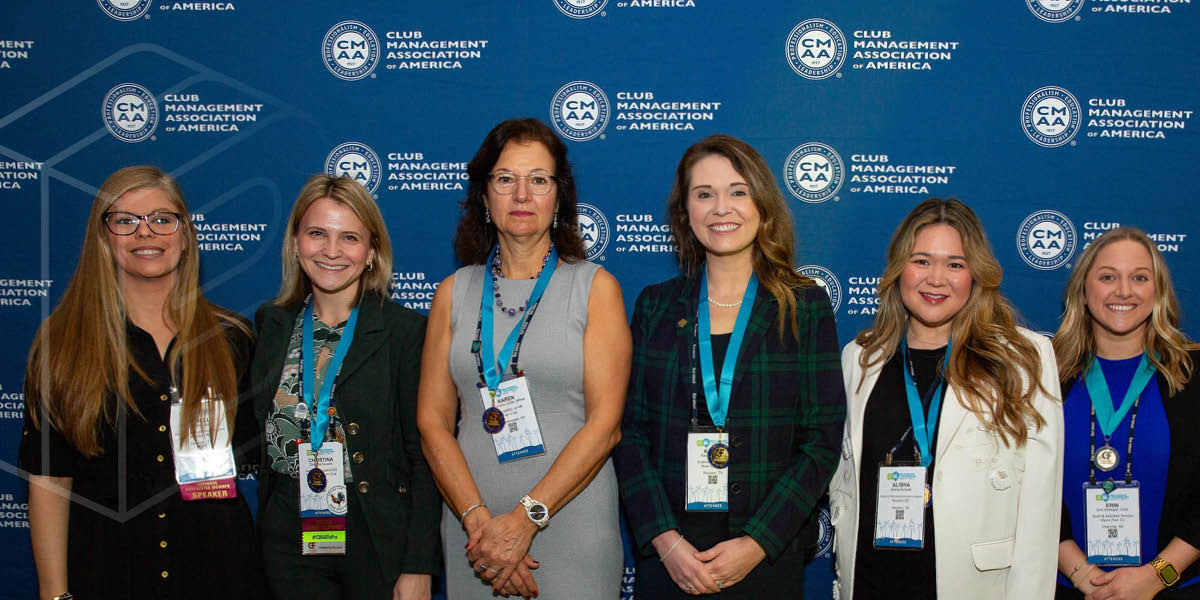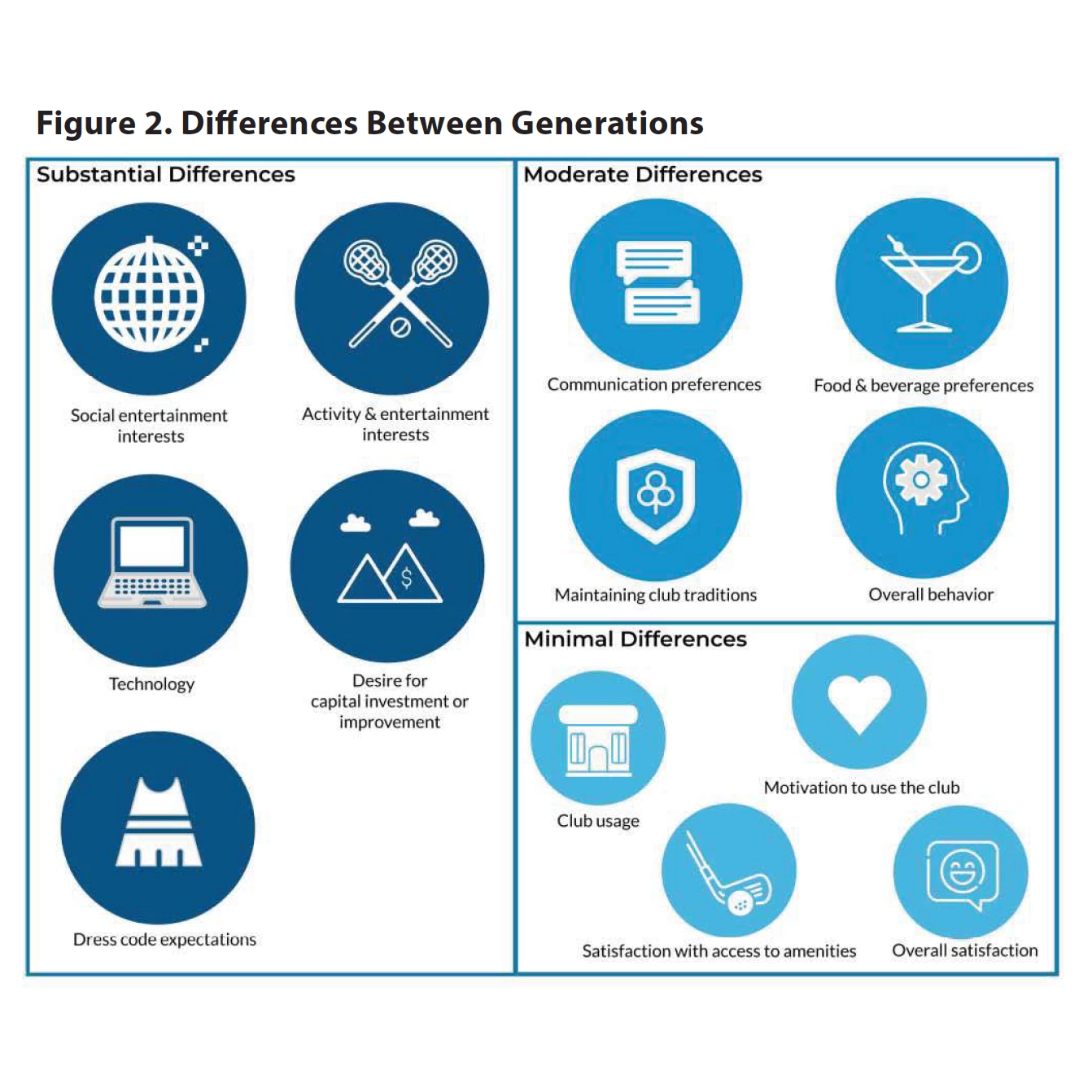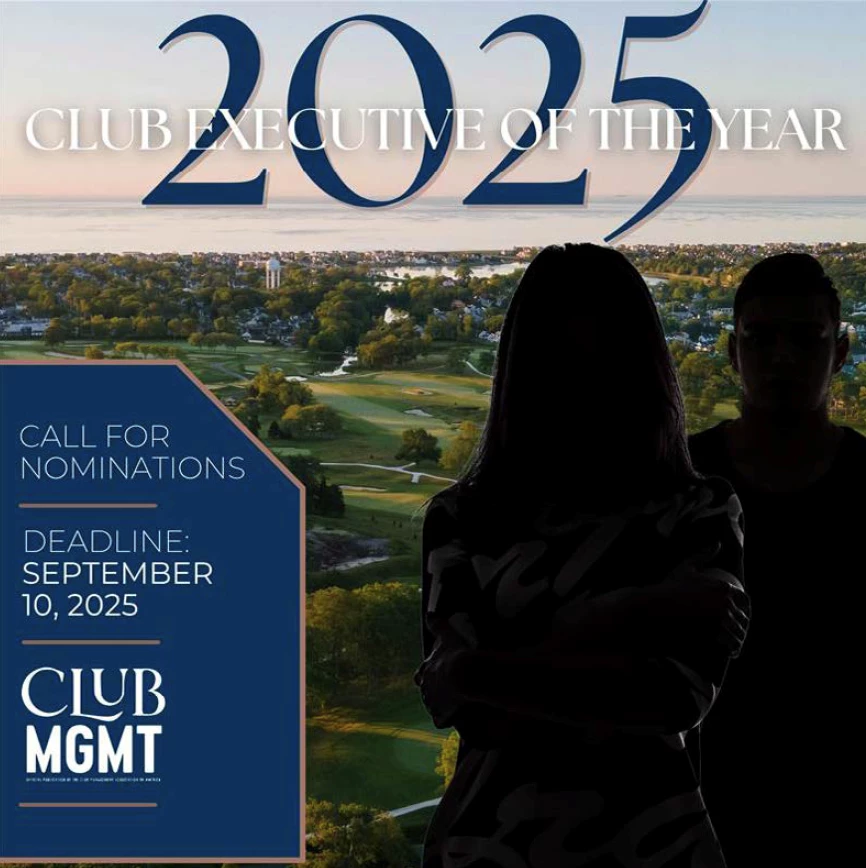Board Brief
August 2025
Designed for Club Board of Directors

Inside this Issue:
-
By the Numbers: Divergent Differences Across Generations
Private clubs face growing generational divides due to differing priorities. Older members often focus more on value for dues, while younger members seek modern amenities and new experiences. Clubs can create connections through social events and effective communication to bridge these gaps. -
What’s Hot: Women Are Influencing Their Clubs’ Futures
EVEolution has emerged in private clubs in the same fashion that renowned futurist Faith Popcorn forecast in her 2000 book of the same name, EVEolution: The Eight Truths of Marketing to Women. As described by Faith and her BrainReserve team, “The way women think and behave is impacting business, causing a marketing shift away from a hierarchical model to a relational one.” -
Insights: Defining and Strengthening Your Club’s Culture
A private club is more than just its golf course, dining venues, or social events—it is a community built on shared values, traditions, and expectations. A strong and clearly defined culture is essential for long-term success, shaping the experiences of both members and employees. -
External Influences: Understanding the Recently Passed Federal Exemptions on Tip and Overtime Income
On July 4, HR1, the 2025 tax legislation, was signed into law. The measure features the extension of several expiring tax cuts passed in 2017 and new tax reductions including the federal tax exemptions for qualifying tip and overtime income. Here are the two impactful changes impacting the club industry. -
CMAA News & Announcements: Podcast Spotlight: Essential Policies for Your Club
It’s never a bad time of year to take time to review your club’s policies and procedures. They are essential for managing effectively and making sound decisions for your members, employees, and volunteer board members. What are these policies and what are the best practices for implementation? Let’s find out! -
CMAA News & Announcements: 2025 Club Executive of the Year: Nominations Due
Annually, Club Management magazine honors a high-performing club management professional who exemplifies excellence in leadership with the Club Executive of the Year Award.

By the Numbers: Divergent Differences Across Generations
Private clubs face growing generational divides due to differing priorities. Older members often focus more on value for dues, while younger members seek modern amenities and new experiences. Clubs can create connections through social events and effective communication to bridge these gaps.
The 2025 edition of the Club Leaders’ Perspective Report from CMAA and GGA Partners dives into these generational challenges. The following is excerpted from the 2025 Club Leaders’ Perspective Report:
Divergent Differences
Respondents were asked to determine the divergence between younger and older members to understand the range of differences. The results indicate that expectations can be divided into substantial, moderate, and minimal differences shown in Figure 2.
Substantial Differences. These areas indicated a substantial difference between generations. Considered gap-creators, these notable differences highlight the need for clubs to develop diverse strategies that cater to the interests of both groups. For instance, efforts to accommodate younger members include providing dynamic social events, adopting modern technology tools, and investing in new and modern amenities. In contrast, older members tend to favor traditional gatherings and communication methods while focusing on maintaining existing facilities.
Differences Between Generations
Moderate Differences. These areas indicate a moderate difference between generations as clubs may find targeted overlap regarding communication, food and beverage preferences, club traditions, and overall behavior. Identifying common ground (and differences) through member surveys among these areas helps identify strategies and actions that effectively balance generational needs and preferences while enabling the club to tailor appropriate tactics.
Minimal Differences. These areas indicate greater alignment among age groups and can be considered relationship building. Club usage, motivation to use the club, and access to amenities are opportunities to bring members together. Younger and older members generally agree on service standards, demonstrate comparable levels of engagement, and share similar motivations for participating in club activities. Despite specific generational differences, overall satisfaction remains relatively consistent, indicating that clubs are generally doing well to strike the correct balance in the overall member experience.
CMAA members may access their complimentary copy of the full report through CMAA Connect in the Best Practices Exchange Community Library in the CMAA Annual Reports folder.

What's Hot
Women Are Influencing Their Clubs’ Futures
EVEolution has emerged in private clubs in the same fashion that renowned futurist Faith Popcorn forecast in her 2000 book of the same name, EVEolution: The Eight Truths of Marketing to Women. As described by Faith and her BrainReserve team, “The way women think and behave is impacting business, causing a marketing shift away from a hierarchical model to a relational one.”
Many female members have reshaped their clubs in three important aspects: governance, amenities, and socialization.
- Governance—Rising generations of women are finding their way into club boardrooms. Today’s women are business executives and community leaders, they know their way around a boardroom where they have previously made tough business decisions and exercised principled leadership.
Beyond making your board more diverse, women represent an important viewpoint that has in past years been unheard or overlooked. Women’s influence in private clubs has changed clubs profoundly in recent years. - Amenities and Facilities—Among the impacts women have had on their clubs are their expectations for club spaces. Impacts that are now taken for granted, such as improved and expended fitness facilities, pickleball, and casual dining, arose from the surge of women into their clubs. Women’s preferences and priorities command most clubs’ needs.
What do women want next at your club? Ask them. Based on GGA Partners’ research, they are likely to cite the importance of more space for activities and greater integration of indoor and outdoor spaces for gathering and activities. They want more programs that bring families—and multiple generations—together. - Socialization – Many women view their club as a platform for socialization. The place where they nurture their children and gather generations, as well as the place to see friends. Alert club leaders and operators recognize this priority for the women in their clubs and engage the club’s women in planning and priority-setting.
At the turn of the century, Faith Popcorn and her BrainReserve team were decades ahead of most private clubs that have now begun to understand the critical value of emphasizing an understanding of what women want.
Submitted by Henry DeLozier, Partner, GGA Partner

Insights
Defining and Strengthening Your Club’s Culture
A private club is more than just its golf course, dining venues, or social events—it is a community built on shared values, traditions, and expectations. A strong and clearly defined culture is essential for long-term success, shaping the experiences of both members and employees. However, establishing and maintaining this culture requires deliberate effort, strategic planning, and a commitment to ongoing refinement.
Understanding the Culture of Your Club
When stepping into a new club—whether as a seasoned general manager or in your first leadership role—it is crucial to ask, “What is the culture of my club?” Culture is often an overused and misinterpreted term, but at its core, it defines how a club operates, how decisions are made, and how people interact within its environment. Without a clearly established culture, clubs risk inconsistency, disengagement, and missed growth opportunities.
To begin this evaluation, leaders must first examine the club’s governance structure. Strong governance is the cornerstone of a well-functioning club and sets the tone for an effective leadership framework. Key questions to consider include:
- Does the club have well-defined processes that foster stability and long-term success?
- Are the roles and responsibilities of the Board, committees, and general manager clearly outlined?
- Is there a robust orientation program for new Board and committee members to ensure alignment with the club’s mission and strategic objectives?
If these structures are not firmly in place, they should be prioritized. A well-governed club fosters an atmosphere of trust and collaboration, ensuring that leadership decisions are aligned with the best interests of the membership and the organization as a whole.
Finding Your Club’s North Star: Mission, Vision, and Core Values
A thriving culture is built upon a shared purpose—one that serves not only the members but also the employees who bring the club’s vision to life. This purpose is typically encapsulated in the club’s Mission, Vision, and Core Values. Many clubs have invested significant time in crafting these guiding principles, but they must be revisited regularly to ensure their relevance.
For a new general manager, it is essential to evaluate whether these statements still reflect the club’s current goals and member expectations. If they are outdated, vague, or disconnected from the club’s daily operations, they must be redefined. A club without a clear and inspiring mission will struggle to foster engagement among both members and staff.
The Often-Overlooked Factor: Employee Experience
While much attention is given to enhancing the member experience, a truly exceptional club culture cannot exist without a thriving employee culture. Engaged and motivated employees are the backbone of superior service, and investing in their success is a direct investment in the club’s overall health.
To cultivate a positive and productive workplace culture, clubs should focus on:
- Comprehensive onboarding—A structured and welcoming onboarding process ensures that new employees quickly integrate into the club’s culture, understand expectations, and feel valued from day one.
- Employee appreciation programs—Recognizing and rewarding staff for their contributions fosters loyalty, boosts morale, and enhances job satisfaction.
- Opportunities for professional growth—Providing clear career pathways, mentorship programs, and ongoing training encourages employees to invest in their futures within the club, reducing turnover and strengthening institutional knowledge.
A club that prioritizes its employees will see improvements in service quality and benefit from a more stable and dedicated workforce.
Collaboration is the Key to Lasting Cultural Success
Developing and maintaining a strong club culture is not the sole responsibility of the general manager. It requires active participation from leadership, staff, members, and industry professionals. Open communication, ongoing education, and a willingness to adapt are critical for long-term success.
By establishing clear governance structures, aligning around a shared mission, and fostering a positive employee experience, clubs can create a culture of excellence—one that enhances member satisfaction, strengthens employee engagement, and ensures the long-term sustainability of the organization.
A well-defined culture is not a static concept; it is a living, breathing aspect of the club that evolves. With a strong foundation in place, clubs can make strategic decisions that support their long-term vision while fostering a welcoming and thriving environment for all who walk through their doors.
Insights by Rob Schlingmann, CCM, CCE, CAM, Senior Club & Community Consultant at Strategic Club Solutions

External Influences
Understanding the Recently Passed Federal Exemptions on Tip and Overtime Income
On July 4, HR1, the 2025 tax legislation, was signed into law. The measure features the extension of several expiring tax cuts passed in 2017 and new tax reductions including the federal tax exemptions for qualifying tip and overtime income. Here are the two impactful changes impacting the club industry.
Tip Income
The legislation creates a four-year, above-the-line deduction for qualified tips received by an individual in an occupation which traditionally and customarily receives tips during a given taxable year.
What Is a Tip? A qualified tip is an “amount… paid voluntarily… determined by the payor.” This generally does not include automatic gratuities or service charges.
When Is This Available? It is retroactive and applicable for FY2025. Individuals can file for the deduction during their annual tax filing beginning in early 2026. It is an above-the-line deduction so individuals will not need to itemize their deductions to qualify.
Annual Deduction Limit: $25,000
Income Limitations: Deduction begins to phase out at $150,000 (modified adjusted gross income) for an individual or $300,000 for a joint return.
What Positions at the Club Qualify? The Secretary of Treasury will be publishing the official list of qualifying occupations within 90 days and can issue further regulations.
Reporting Requirements: Employers will be required to furnish statements to the Treasury and the individual employee detailing tip income and the individual’s qualifying occupation. More specifics should be detailed by the Secretary of the Treasury.
Expiration: This deduction expires at the end of FY2028.
Impact Forecast: A notable 63.2 percent of clubs have transitioned from traditional tipping models to service charges for member dining. Many clubs may consider reversing course. If employees begin pushing for a return to a tip-based system due to perceived increased financial benefits, clubs may feel pressure to comply to maintain their workforce. Additionally, recruitment dynamics could shift with competing local restaurants and hospitality businesses.
Overtime Income
The legislation creates a four-year, above-the-line deduction for qualified overtime income received by an individual.
How Is Overtime Income Defined? Qualified overtime compensation is compensation paid to an employee as required by the Fair Labor Standards Act.
When Is This Available? It is retroactive and applicable for FY2025. Individuals can file for the deduction during their annual tax filing beginning in early 2026. It is an above-the-line deduction, so individuals will not need to itemize their deductions to qualify.
Annual Deduction Limit: $12,500 for an individual or $25,000 for a joint return
Income Limitations: Deduction begins to phase out at $150,000 for an individual or $300,000 for a joint return (modified adjusted gross income).
Reporting Requirements: Employers will be required to include overtime compensation on the annual W-2
Further Regulations: The Secretary of the Treasury will issue further regulatory guidance.
Expiration: This deduction expires at the end of FY2028.
Impact Forecast: With clubs continuing to face staffing challenges, could this help clubs lean on existing staff to meet additional hourly needs? Will non-exempt employees be incentivized to work more overtime?
CMAA News & Announcements
Podcast Spotlight: Essential Policies for Your Club
It’s never a bad time of year to take time to review your club’s policies and procedures. They are essential for managing effectively and making sound decisions for your members, employees, and volunteer board members. What are these policies and what are the best practices for implementation? Let’s find out!
In the 139th episode of Let’s Talk Club Management, we are diving into the article, Seven Essential Policies for Your Private Club in 2025. We are excited to have all three authors from PKF O'Connor Davies with us to dive into this important topic.
2025 Club Executive of the Year: Nominations Due September 10
Annually, Club Management magazine honors a high-performing club management professional who exemplifies excellence in leadership with the Club Executive of the Year Award. Created 40 years ago as the Club Manager of the Year Award, today the distinction specifically recognizes top-level executives whose sustained contributions have had a significant impact on their clubs, communities, and the broader profession.
Help us honor an extraordinary club management professional who raises the bar in club management and within the CMAA community. CMAA welcomes and encourages nominations from diverse backgrounds and work experiences.
Please review the full criteria, nomination packet requirements, judging process, and notification information available online. All nomination materials must be received by September 10.




